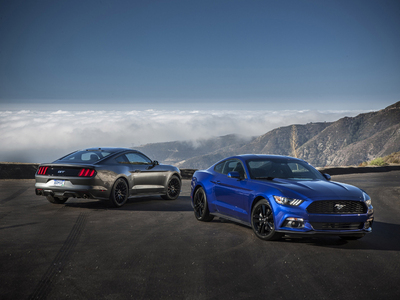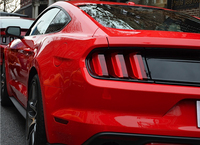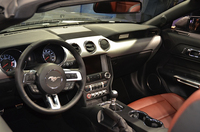2015 Ford Mustang 2.3 EcoBoost Review +VIDEO
 2015 Ford Mustang |
This Ford Mustang is the best yet. By far.
DRIVING DOWN THE ROAD WITH CAREY RUSS
• SEE ALSO: Ford Buyers Guide
 2015 Ford Mustang |
The term "all-new" is overused in the auto industry. But it's true, and possibly even an understatement, in the case of the 2015 version of Ford's iconic Mustang. For the first time ever, independent rear suspension is standard on all series-production models, even the "lowly" V6. Why that "lowly" in quotes? Every one of the three engines offered for the newest Mustang makes 300 horsepower or more. There have been times in the dark past that performance was not really a Mustang attribute. Model year 2015 is not one of those times.
The "entry-level" 3.7-liter V6 puts out maxima 300 horsepower -- as much as the 4.6-liter V8 of a decade ago -- and 280 lb-ft of torque. Need more? That would be the 2.3-liter "EcoBoost" turbocharged four-cylinder engine, with 310 hp and 320 lb-ft. Your style is more like "nothing succeeds like excess"? 5.0 V8: 435 hp and 400 lb-ft. All in a chassis that, unlike some of the less illustrious Mustangs of the past, is more than capable of handling the power.
What's not new is a shorter list than what's new in the sixth-generation Mustang, which is offered in fastback coupe and convertible form with all powertrains. Rigidity of the unibody structure has been increased, all the better to deal with the revised front and all-new rear suspensions and their capability for serious cornering grip. The shape is instantly familiar, but all body panels are new, and the car is lower and slightly wider. During design, much attention was paid to aerodynamic details, to improve both fuel economy and stability at speed. The interior is also all new and vastly improved.
The first 2015 Mustang I drove was a 5.0 GT, at a journalists' track day at Mazda Raceway Laguna Seca a few months back. It was thunderous fun, loud and rowdy but completely stable and civilized -- a long, long way from the flint-axe character of the long-lived Fox-platform 5.0s of the past, and even noticeably better than the previous generation's performance models.
Because of EPA fleet fuel economy regulations, Ford is expanding the "EcoBoost" turbo concept. It's hardly an anathema to performance, witness the Fiesta and Focus ST models. And there is an historical precedent for a turbocharged four-cylinder engine in a Mustang, with a Turbo model in the early 1980s and especially with the SVO of 1984 through `86. The SVO offered performance equal to that of the contemporary V8, with much better handling thanks to considerably less weight between the front wheels. It was also much pricier than the V8, so few were sold.
Today, the EcoBoost is not in direct competition with the 5.0 V8. But it is about 200 pounds lighter, with most of that weight reduction at the front. And the suspension, especially with the optional Performance Package with which last week's test car was equipped, is eminently capable, whether on the road, in a parking lot autocross, or at a track day. I recently had the opportunity to participate in the Ford EcoBoost Challenge (see sidebar). One of the events was a very good autocross course, cars of choice Mustangs. EcoBoost, of course, and with both stick and automatic. The transmission made very little difference, second gear is second gear, and in convertible or coupe form the new Mustang was an exemplary performer. On the road, ditto. The sport suspension was appropriately firm, but never uncomfortable. This car was an automatic. I'd personally prefer a stick, but no problem here as manual shifting via paddles could be done. It liked to be driven hard, and seemed more precise when pushed a bit. That's not something that can be done all the time, and it was docile and compliant in traffic and quite comfortable. The rear seat of a Mustang has never been known for spaciousness, and that hasn't changed -- but there is a trunk and this is a car that can be your only car, no problem. It's also the best standard-production Mustang ever.
2016 changes: Don't expect anything major. Price may vary by location and equipment. There is a Shelby GT350 version coming, with a 5.2-liter flat-plane crank V8 that makes 526 horsepower and 429 lb-ft of torque in case a regular 5.0 GT isn't quite enough.
APPEARANCE: Everything has changed, yet the new Mustang is instantly recognizable. Compared to the previous generation, the coupe has a more fastback roofline, and looks more like a two-seater than a 2+2. Its muscular and toned, but without steroids. The grille shape establishes continuity with its predecessor, and the triple vertical taillights are the newest interpretation of a long-time Mustang styling cue. The double-edged dome on the hood is also familiar -- but all styling elements blend seamlessly and coherently. Even the projecting "aero kit" bits around the lower perimeter look right, and not like afterthought add-ons.
 2015 Ford Mustang |
COMFORT: "Mustang" has never been synonymous with "luxury appointment" and that works just fine for the intended audience. Here, appropriately, the emphasis is on driving, and good support and comfort from the driver's seat, complete steering wheel adjustability, and reasonable visibility are important for serious driving. And safety. Seating surfaces are leather, with the front seats six-way power-adjustable and both heated and cooled. The climate control system works quickly and efficiently. Instrumentation is beyond complete, with the tach, main information display, and speedometer easily visible in front of the driver and auxiliary gauges to the right. Or perhaps left, as there are right-hand drive examples for those markets. There is a boost gauge there, presumably to entertain the front passenger / navigator as when it's moving the driver had best be paying attention to the road. Electronic engine management removes the need to monitor boost.
The steering wheel has a thick leather rim and controls for audio, cruise, and information systems. There is a locking glovebox, simple cupholders are on the console, and audio choices here, with the Shaker Pro audio system, are AM, FM, and Sirius/XM radio, CD, and external device, meaning jack, USB, and SD card in the console box. The rear semi-bucket arrangement is strictly for two, and they had best be shorter than about 5-4. Meaning that the kids will fit, a selling point for many a "+2" sports car and far more spacious than the Sunbeam Alpine my parents had when I was young. There is a useful amount of trunk space, largely because there is no spare tire, just an inflation kit. As is increasingly common and hardly a demerit only to the Mustang.
RIDE AND HANDLING: It only took 50 years, but all Mustangs now have independent rear suspension (IRS). Yes, there have been special-edition Mustangs and aftermarket conversions with IRS before, but no regular production models. What's the big deal? Better control of wheel movement for improved roadholding, especially on uneven surfaces, and greater comfort. Drawback, and why it took so long? Cost -- more parts and more complexity. But the previous Mustang was the last performance car, and about the last non-truck vehicle, to have a solid rear axle. It works, and should work especially well when pushed hard. The new Mustang is a natural-born autocrosser, and is also solid and secure on the road, even when surfaces are less than ideal. Steering effort varies with driving mode, see below. The Performance Package adds larger discs, vented in the read as well as front, and four-piston front calipers for the EcoBoost. Even bigger rotors and six-pot Brembo calipers for the GT. It stops!
PERFORMANCE: How does turbocharging improve fuel economy? That all depends on how you use the turbo… gentle acceleration and short-shifting mean less boost, less fuel and air, and better economy. You bought a turbo Mustang for that, right? Didn't think so…
More realistically, a smaller four-cylinder engine weighs less than a V8, even with turbo, intercooler, and all the required plumbing. Current V6 and EcoBoost Mustangs weigh about the same and have similar horsepower, so you get the turbo for the much greater torque -- 40 lb-ft more -- and the available Performance Package. All current Mustang engines are of aluminum alloy construction, with dual overhead cams with continuous phasing, four valves per cylinder, and would have been enthusiasts' dreams in the days of the SVO. The 2.3 EcoBoost makes 310 horsepower (at 5500 rpm) and 320 lb-ft of torque from 2500 through 4500 rpm. Which makes shifting an option, and means that the automatic is not a performance-robber.
With the Performance Package come Sport, Sport+, and Track driving modes. Throttle response and steering effort increase, and traction and stability control assistance decrease (and are off in Track). With the automatic, shift points go higher and shifts get quicker and firmer, manually or automatically. This car felt a little soft, with darty steering in default mode. Sport quickly became my default, and the harder I drove the car, the happier it felt. I can be a daily driver, just ignore the standard settings to get the best feel for the car. Fuel economy? Long-term was 22.3 mpg, similar to what I saw with a previous-generation V6 with basically the same engine as the current V6. During my time, with short city drives, backroad fun, and minimal highway, 19. Sport+ or Track and lots of heavy throttle? Put it on the entertainment budget!
CONCLUSIONS: The newest Ford Mustang is the best yet. By far.
SPECIFICATIONS
2015 Ford Mustang 2.3
Base Price $ 29,300
Price As Tested $ 36,965
Engine Type DOHC 16-valve aluminum alloy inline 4-cylinder with variable cam phasing, turbocharging and intercooling, and direct fuel injection
Engine Size 2.3 liters / 140 cu. in.
Horsepower 310 @ 5500 rpm
Torque (lb-ft) 320 @ 2500-4500 rpm
Transmission 6-speed automatic (optional)
Wheelbase / Length 107.1 in. / 188.3 in.
Curb Weight 3524 lbs.
Pounds Per Horsepower 11.4
Fuel Capacity 15.5 gal.
Fuel Requirement 91 octane unleaded premium gasoline for best performance,87 octane unleaded regular gasoline acceptable
Tires 255/40ZR19 96Y Pirelli P-Zero
Brakes, front/rear vented disc with four-piston fixed calipers / vented disc with single-piston floating calipers
Suspension, front/rear independent MacPherson strut / independent integral link
Drivetrain front engine, rear-wheel drive
PERFORMANCE
EPA Fuel Economy - miles per gallon city / highway / observed 21 / 32 / 22
0 to 60 mph 5.2 sec
OPTIONS AND CHARGES
Shaker Pro Audio System $1,795
6-Speed Select Shift Automatic $1,195
Enhanced Security Package $ 395
Adaptive Cruise Control $1,195
EcoBoost Performance Package -- includes: 255/40R19 summer tires, rear spoiler delete, 3.55:1 limited-slip differential, upgraded brakes $1,995
Reverse Park Assist $ 295
Voice-Activated Navigation System $ 795
Destination Charge $ 825
Sidebar: The EcoBoost Challenge
Automakers have a variety of ways to reach out to potential customers. One is to stage events that compare their cars and trucks to those of competitors and invite potential buyers to try them out, back-to-back. How do you get invited? Maybe the mystery of mailing lists, or answering surveys… or by being in the press and being invited to check it out and then tell the world. I've been to more than a few over the years, usually before the public but sometimes in with everyone else.
The venue is usually somewhere with a large expanse of asphalt, like a stadium parking lot when nothing else is happening. Various driving events are set up, to feature the manufacturer's car against the competition. This EcoBoost Challenge featured various Ford EcoBoost vehicles against perceived competitors for some events, and against the clock to showcase acceleration or maneuverability for others. There was a slalom / road course, cones but not for autocross speeds, for Ford's F150 and Escape, both with EcoBoost engines, against a Chevrolet Silverado and Honda CR-V, timed reaction-time trials with Fiesta and Focus STs, and an autocross with EcoBoost Mustangs, both stick and automatic. Interestingly, but I suppose unsurprisingly, there was also instruction available on how to drive a manual transmission, for those who never had.
Was it rigged to the benefit of Ford products? Not particularly -- I liked the CR-V better than the Escape on the course. The F150 handily beat the Silverado for comfort and maneuverability. YMMV… Was there pressure to go Ford? There was plenty of information available about the vehicles, but as far as I could tell no "hard sell" of any kind.
It's kind of like those "free dinner" presentations I keep getting in the mail (and ignoring) -- sit through a presentation on time-share condos or investment opportunities or retirement strategies or whatever and resist a sales pitch in exchange for a free dinner. But no direct sales pitch -- maybe some slightly unfair comparisons between vehicles, or maybe not, not here at least -- and no meal. There is no free lunch anyway, Robert Heinlen was right.


